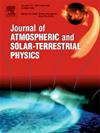Longitudinal responses of phase scintillation from ground stations during geomagnetic storms
IF 1.8
4区 地球科学
Q3 GEOCHEMISTRY & GEOPHYSICS
Journal of Atmospheric and Solar-Terrestrial Physics
Pub Date : 2025-03-03
DOI:10.1016/j.jastp.2025.106452
引用次数: 0
Abstract
This study analyzed the longitudinal variations of phase scintillation over United States (AB21 and AC66), Canada (UCLU, CAGS, ESCU, and STJO), Germany (HUEG and WTZZ), Ukraine (UZHL), Kazakhstan (KRTU), and Russia (BADG) sectors as the result of the intense geomagnetic storms of March 2015, June 2015, and December 2015 during solar cycle 24. Ground-based Global Positioning System (GPS) receivers, solar wind speed and magnetic (IMF Bz and Dst) data are used for this study. Total Electron Content (TEC) was used to derive the ionospheric phase scintillation/irregularities proxy indices, e.g., rate of change of TEC (ROT) and ROT index (ROTI).These indices were characterized alongside with the Disturbance Storm Time (Dst), Solar Wind Speed (Vsw), and Z component of Interplanetary Magnetic Field (IMF Bz) to see the effect of geomagnetic storm on horizontal component of geomagnetic field. Prompt Penetration of Electric Field (PPEF) modulated the behavior of irregularities during the initial and recovery phases of the geomagnetic storms (Demelash and Kassa, 2023). As a result, irregularities in the ionosphere over Canada, Germany, Ukraine, Kazakhstan, and Russia were found to range from weak to moderate in intensity. Regions in the United States, however, ranged between weak and strong. These phase scintillation generally occurred during the initial, main, and recovery phases of the storms at all selected stations. The effect of electric field was found to depend on the local time at which the IMF Bz turned into southward. The generation (inhibition) of phase scintillation is related to the effect of eastward (west-ward) storm time electric field disturbance dynamo electric fields and prompt penetration electric fields that created favorable (unfavorable) conditions for the generation of irregularities by uplifting (lowering) the F region. These findings highlight the presence of phase scintillation and fluctuations during different phases of geomagnetic storms, with varying intensities and durations across multiple locations.
地磁风暴期间地面站相位闪烁的纵向响应
本文分析了2015年3月、6月和12月第24太阳活动周强烈磁暴对美国(AB21和AC66)、加拿大(UCLU、CAGS、ESCU和STJO)、德国(HUEG和WTZZ)、乌克兰(UZHL)、哈萨克斯坦(KRTU)和俄罗斯(BADG)扇区相位闪烁的纵向影响。本研究使用了地面全球定位系统(GPS)接收器、太阳风速度和磁场(IMF Bz和Dst)数据。利用总电子含量(TEC)推导电离层相位闪烁/不规则性代用指标,如TEC变化率(ROT)和ROT指数(ROTI)。将这些指标与扰动风暴时间(Dst)、太阳风速度(Vsw)和行星际磁场Z分量(IMF Bz)一起进行表征,观察地磁风暴对地磁场水平分量的影响。快速穿透电场(PPEF)调节了地磁风暴初始和恢复阶段的不规则行为(Demelash和Kassa, 2023)。结果发现,加拿大、德国、乌克兰、哈萨克斯坦和俄罗斯上空的电离层异常强度从弱到中等不等。然而,美国的一些地区则有强有弱。这些相位闪烁通常发生在所有选定站点的风暴初始阶段、主要阶段和恢复阶段。电场效应与IMF Bz向南转变的当地时间有关。相位闪烁的产生(抑制)与东(西)风时电场扰动、发电机电场和提示穿透电场的作用有关,这些电场通过抬升(降低)F区为不规则的产生创造了有利(不利)条件。这些发现强调了在地磁风暴的不同阶段存在相位闪烁和波动,在多个地点具有不同的强度和持续时间。
本文章由计算机程序翻译,如有差异,请以英文原文为准。
求助全文
约1分钟内获得全文
求助全文
来源期刊

Journal of Atmospheric and Solar-Terrestrial Physics
地学-地球化学与地球物理
CiteScore
4.10
自引率
5.30%
发文量
95
审稿时长
6 months
期刊介绍:
The Journal of Atmospheric and Solar-Terrestrial Physics (JASTP) is an international journal concerned with the inter-disciplinary science of the Earth''s atmospheric and space environment, especially the highly varied and highly variable physical phenomena that occur in this natural laboratory and the processes that couple them.
The journal covers the physical processes operating in the troposphere, stratosphere, mesosphere, thermosphere, ionosphere, magnetosphere, the Sun, interplanetary medium, and heliosphere. Phenomena occurring in other "spheres", solar influences on climate, and supporting laboratory measurements are also considered. The journal deals especially with the coupling between the different regions.
Solar flares, coronal mass ejections, and other energetic events on the Sun create interesting and important perturbations in the near-Earth space environment. The physics of such "space weather" is central to the Journal of Atmospheric and Solar-Terrestrial Physics and the journal welcomes papers that lead in the direction of a predictive understanding of the coupled system. Regarding the upper atmosphere, the subjects of aeronomy, geomagnetism and geoelectricity, auroral phenomena, radio wave propagation, and plasma instabilities, are examples within the broad field of solar-terrestrial physics which emphasise the energy exchange between the solar wind, the magnetospheric and ionospheric plasmas, and the neutral gas. In the lower atmosphere, topics covered range from mesoscale to global scale dynamics, to atmospheric electricity, lightning and its effects, and to anthropogenic changes.
 求助内容:
求助内容: 应助结果提醒方式:
应助结果提醒方式:


